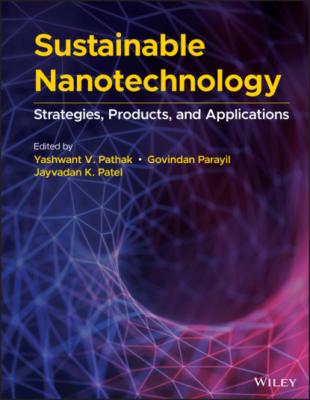Sustainable Nanotechnology. Группа авторов
Читать онлайн.| Название | Sustainable Nanotechnology |
|---|---|
| Автор произведения | Группа авторов |
| Жанр | |
| Серия | |
| Издательство | |
| Год выпуска | 0 |
| isbn | 9781119650317 |
Even though NT involves manipulating matter on an atomic, molecular, and supramolecular scale, the particular technological goal is of precisely manipulating atoms and molecules for the fabrication of macroscale products, also now referred to as molecular NT. NT being a general‐purpose technology encompassing four generations of products with increasing structural and dynamic complexity as (i) passive nanostructure (ii) active nanostructures, (iii) nanosystems, and (iv) molecular nanosystems. It is predicted that by 2020, the increasing integration of nanoscale science and engineering knowledge and of nanosystems promises mass applications of NT in industry, medicine, and computing and in better comprehension and conservation of nature. NT's rapid development worldwide is supporting this anticipation of its expected progress of transforming the society and the future of living beings. However, the slow pace of actual progress against predicted roadmap has been re‐examined and based on more planned efforts to be made by country governments and NT research organizations. The modified timeline of NT industry progress is predicted by Aithal et al. [4, 5] based on the last 15 years development trend and it is listed in Table 3.1. The delay is mainly due to the fear and caution of many scientists, organizations, and country governments on fast acceptance for the NT commercialization process. However, through currently developed and proven green and eco‐friendly NT processes further accelerates the nanotechnology growth and to stick the timeline as perpredicted in Table 3.1.
Table 3.1 Anticipated timeline of nanotechnology innovations [5].
| Nanotech generations | Development | Examples | Prediction by Roco and coworker [6] | Prediction by Aithal and Aithal [5] |
|---|---|---|---|---|
| First generation | Passive nanostructures | Nanomaterials, including nanotubes and nanolayers | 2000–2005 | 2000–2015 |
| E.g., coatings, nanoparticles, nanostructured metals, polymers, ceramics | ||||
| Second generation | Active nanostructures | Change their state during use, responding in predictable ways to the environment | 2006–2010 | 2016–2020 |
| E.g., 3D transistors, amplifiers, targeted drugs, actuators, adaptive structures | ||||
| Third generation | Nanosystems | Assemblies of nanotools work together to achieve a final goal | 2011–2015 | 2021–2035 |
| E.g., guided assembling; 3D networking and new hierarchical architectures, robotics | ||||
| Fourth generation | Molecular nanosystems | Involves the intelligent design of molecular and atomic devices, leading to unprecedented understanding and control over the basic building blocks of all natural and man‐made things | 2016–2020 | 2036–2050 |
| E.g., molecular devices “by design,” atomic design, gene therapy | ||||
| Fifth generation | Singularity | Growth rate in NT applications becomes infinite | 2020–2025 | Beyond 2050 |
As per the Table 3.1, NT is in the transition from its second generation to the third generation. The active nanostructures like 3D transistors, amplifiers, targeted drugs, actuators, adaptive structures using metal‐nanomaterials, metal‐nanocomposites, semiconductor nanocomposites, and nano‐quantum dots are achieved and the next generation of nanosystems to fabricate Guided assembling systems, 3D networking systems, and new hierarchical architecture systems and robotics using nanosystems are approaching from coming years. The developed nanosystems for the next industrial revolution called industry 5.0 with the objective of total automation and mass customization can be achieved only if the fear of adopting NT systems in industries. By means of developing and promoting green and eco‐friendly nanosystems [7, 8], the technology can spread at an accelerated speed, and many more components, devices, and systems will be commercialized from different industries. NT can become a part of ideal technology that can solve all problems of society optimally, provided the potential risks are taken care of.
In this chapter, we have analyzed the benefits and risks of NT and suggested how to use green nanotechnology (GNT) models to solve the potential risks. Such an attempt on greening nanotechnology applications will add value to the products and processes that are related to basic needs, advanced wants, and dreamy desires of the people. The discussions are based on the systematic analysis of the opportunities and challenges using standard frameworks on primary industry sector, secondary industry sector, tertiary industrial sector, and quaternary industry sector to interpret the importance of the advent of GNT in society.
3.2 Related Works
GNT deals with environmentally friendly processes of preparation, large‐scale manufacturing, and industrial use of nanomaterials by minimizing environmental degradation and potential risks of health hazards. A systematic review of important related works published recently on various underlying areas of GNT is listed in Table 3.2 by identifying issues of environmental degradation. Based on the review and current understanding of various issues of environmental degradation, the opportunities and challenges of using NT as green and eco‐friendly technology are discussed and analyzed.
3.3 Objectives and Research Methodology
To understand the possibility of using emerging NT as green and eco‐friendly technology by means of the following objectives:
1 To identify green processes for nanomaterial preparation, handling, and conversion into nanosystems.
2 To discuss the opportunities and challenges of GNT in the primary industry sector including agriculture, forestry, mining, fisheries, etc.Table 3.2 Review on research scholarly publications in green nanotechnology‐related areas.S. No.AreaIssue and outcomeReferences1Environmental challenges
